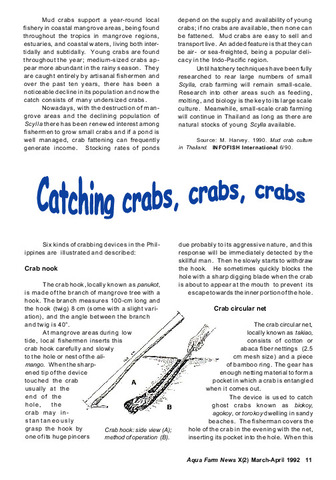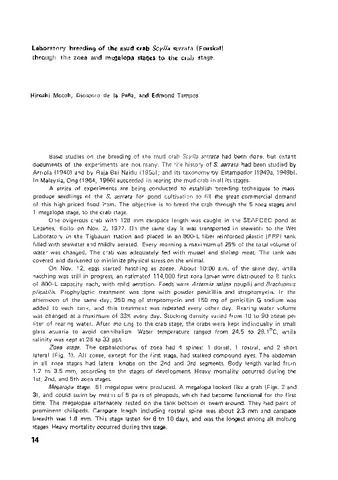Status of mud crab aquaculture in Bangladesh
| dc.contributor.author | Islam, Md. Sherazul | |
| dc.contributor.editor | Quinitio, Emilia T. | |
| dc.contributor.editor | Estepa, Fe Dolores P. | |
| dc.contributor.editor | Thampi Sam Raj, Yohannan C. | |
| dc.contributor.editor | Mandal, Anup | |
| dc.date.accessioned | 2017-09-04T10:09:09Z | |
| dc.date.accessioned | 2017-09-04T10:40:00Z | |
| dc.date.accessioned | 2017-09-05T08:46:43Z | |
| dc.date.available | 2017-09-04T10:09:09Z | |
| dc.date.available | 2017-09-04T10:40:00Z | |
| dc.date.available | 2017-09-05T08:46:43Z | |
| dc.date.issued | 2015 | |
| dc.identifier.citation | Islam, M. S. (2015). Status of mud crab aquaculture in Bangladesh. In E. T. Quinitio, F. D. Parado-Estepa, Y. C. Thampi Sam Raj, & A. Mandal (Eds.), Proceedings of the International Seminar-Workshop on Mud Crab Aquaculture and Fisheries Management, 10-12 April 2013, Tamil Nadu, India (pp. 1-6). Tamil Nadu, India: Rajiv Gandhi Centre for Aquaculture (MPEDA). | en |
| dc.identifier.isbn | 9788192989815 | |
| dc.identifier.uri | http://hdl.handle.net/10862/3204 | |
| dc.description.abstract | Bangladesh has about 710 km of coastlines with 618,780 ha of mangrove tidal flats and 80,000 ha of associated areas which are suitable for brackishwater aquaculture. Mud crab culture has been practiced for many years in the coastal regions, particularly in southeast (Chittagong, Cox’s Bazar, Chokoria and Noakhali) and southwest (Khulna, Bagherhat and Satkhira) Bangladesh. In 1981, crab export became a stable business which ranked third among the fisheries export earnings. Bangladesh earns about US$6 million per year by exporting 1,500 metric tons of live mud crabs to Singapore, Hong Kong, China, Taiwan and Japan. Mud crab has been an incidental product arising from the culture of shrimps and other finfishes in ponds. Mud crabs were first exported in 1977 and since then farmers focused their attention to this species as an alternative to shrimp. However, mud crab farming is still dependent on wild resources. As the demand of mud crab in the international market increased, the number of crab gatherers also significantly increased. In addition, gathering of sub-adult crabs for fattening contributed to the depletion of adult crabs as breeders. Since the wild resources are under threat, management of resources and establishment of hatcheries are needed to sustain the mud crab industry in Bangladesh. | en |
| dc.language.iso | en | en |
| dc.publisher | Rajiv Gandhi Centre for Aquaculture (MPEDA) | en |
| dc.subject | Mud crab | en |
| dc.subject | Bangladesh | en |
| dc.subject | Crab fattening | en |
| dc.subject | Cage and pens | en |
| dc.subject | captive breeding | en |
| dc.title | Status of mud crab aquaculture in Bangladesh | en |
| dc.type | Conference paper | en |
| dc.citation.spage | 1 | |
| dc.citation.epage | 6 | |
| dc.citation.conferenceTitle | Proceedings of the International Seminar-Workshop on Mud Crab Aquaculture and Fisheries Management, 10-12 April 2013, Tamil Nadu, India | en |
| dc.subject.asfa | breeding | en |
| dc.subject.asfa | crab culture | en |
| dc.subject.asfa | crustacean culture | en |
| dc.subject.asfa | seed production | en |
Files in this item
| Files | ขนาด | รูป | View |
|---|---|---|---|
|
There are no files associated with this item. |
|||
รายการนี้ปรากฏใน (s)
-
International Seminar-Workshop on Mud Crab Aquaculture and Fisheries Management (ISMAF 2013) [15]
Proceedings of the International Seminar-Workshop on Mud Crab Aquaculture and Fisheries Management, 10 - 12 April 2013



